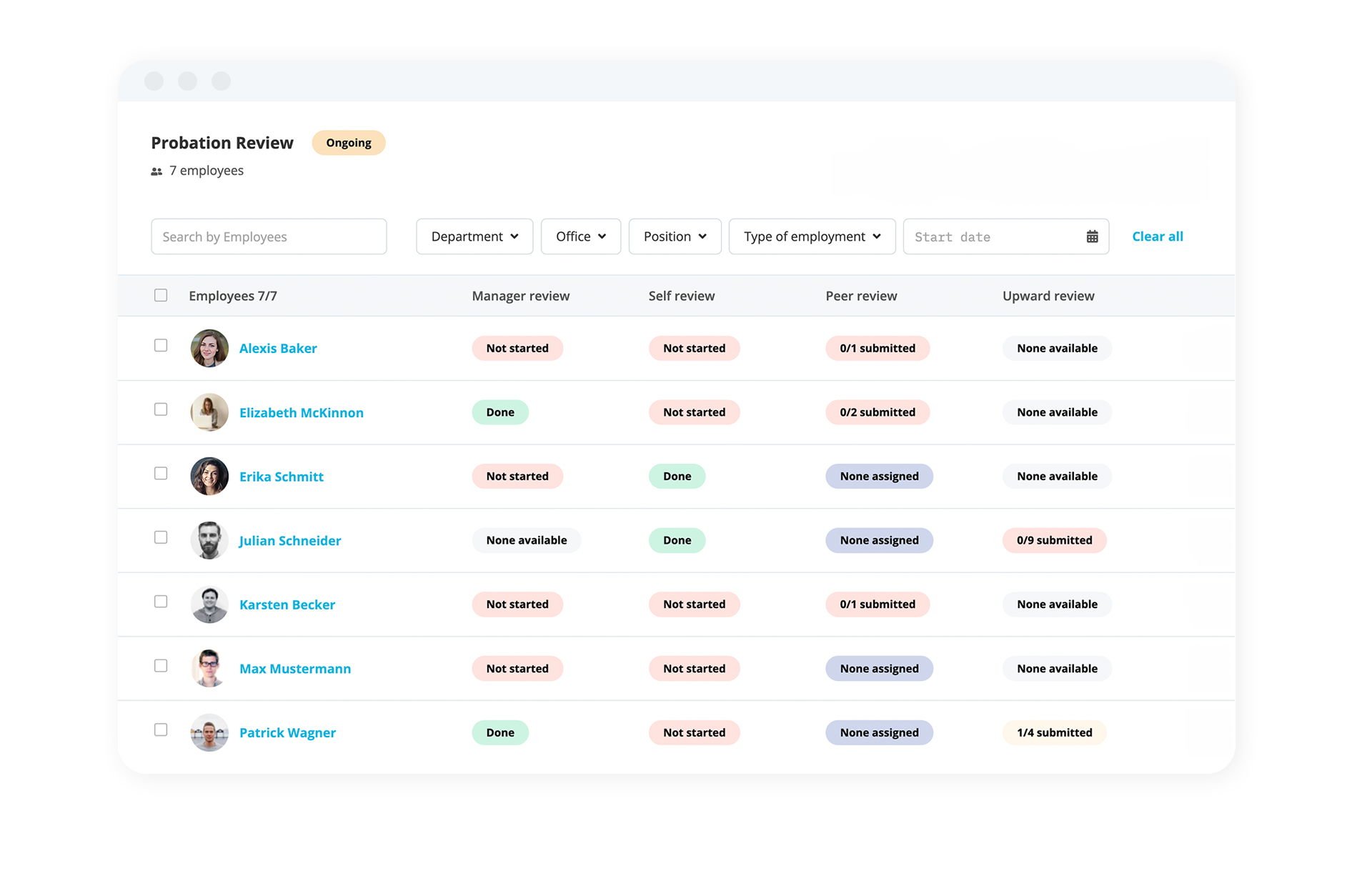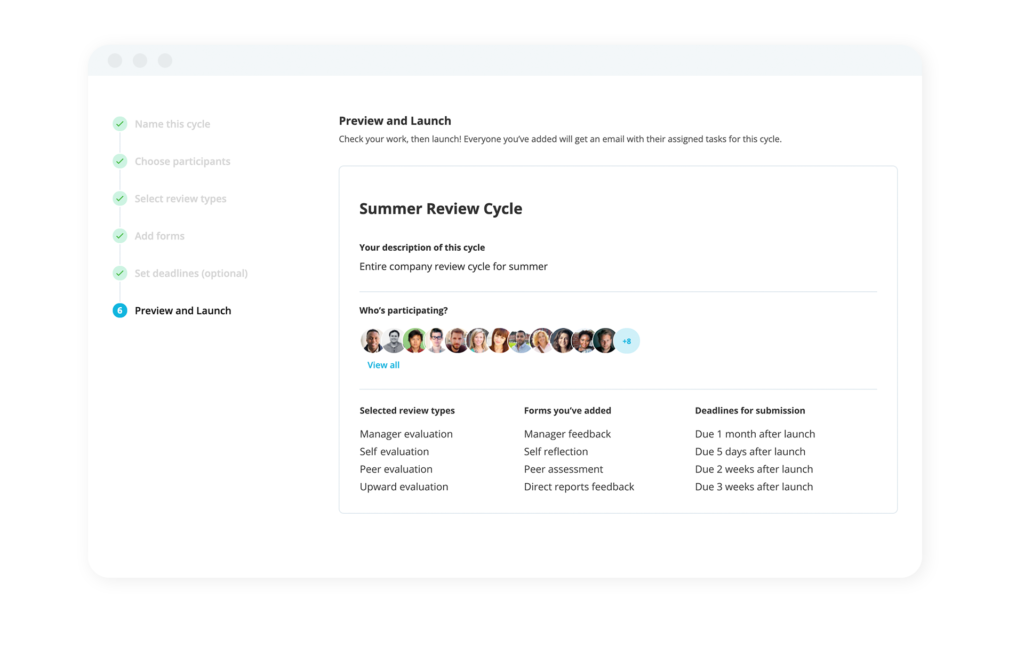
Automated Performance Cycles
Run an automated performance cycle that really works.
Performance Cycles With PersonioSkills Mapping Guide for HR Professionals
If you’ve ever been curious about the full scope of skills contained in your organisation, skills mapping can be a helpful exercise. While you can look at your employees and see their day-to-day capabilities, there are likely other skills and knowledge going unnoticed and being underutilised.
Just as a city map can show a traveller where they are and how to get to their destination, a skills map can help businesses visualise their employees’ full range of abilities.
In this guide, Personio explores how skills mapping works and how HR professionals specifically can use the tactic.
Key Facts
Skills mapping helps teams visually map out the skills that are needed and compare that to what the organisation currently has available.
Teams can use tools like the capability matrix and competency matrix to illustrate the skills, knowledge and abilities each employee or team has.
The process of skills mapping requires HR teams to get clear on which skills are needed, which employees have those skills (at what levels) and where there may be skills gaps that the organisation needs to fill.
Skills Mapping Explained
Skills mapping is a process used to visually map out the skills, knowledge and abilities needed to perform competently in a role, and comparing that with what the organisation currently has available. Comparing needed skills with available skills enable the business to identify potential skills gaps – something 43% of organisations are dealing with – and assess the level of training and development needed to fill them.
Benefits of Skills Mapping
Skills mapping offers a variety of benefits to businesses of all sizes, including:
Visualising organisational needs to better understand them
Evaluating organisation skills as a whole
Determining which staff members could benefit from more training
Assessing the skill level of each employee relative to others
Understanding which employees are generalists vs. specialists
Identifying the most critical organisational tasks and needs
Uncovering skills gap filling opportunities within the organisation
Demonstrating which employees add the most value to the business
Utilising skills data to guide hiring decisions
Tracking the development and improvement of individuals and departments over time
Formulating a list of staff who can be substitutes for or replace other employees
Acquiring insight into employees' career ambitions
Give Potential Room To Grow With Personio

Automate your performance cycles to open up time for job enrichment with Personio today.
Find Out More
Capability & Competence Matrix in Skills Mapping
Because skills mapping is a visual process, matrices can be a helpful tool for organisations to map the skills they have access to and any skills gaps that might exist. Two types of matrices that are often used in the skills mapping process are the capability matrix and the competence matrix.
Capability Matrix
A capability matrix outlines performance expectations for each job role, helping team leads monitor skills, expertise and behaviours of team members (and track any skills gaps). This matrix provides insights and data to guide an organisation's long-term talent strategy and business growth.
A good capability matrix has 360-degree coverage, mapping out the employee or department’s skills and capabilities with updates added by both staff and those in management.
Competency Matrix
The terms competency matrix and skills matrix are often used interchangeably. Both are table frameworks that map employees with their level or rank on a specific skill.
This type of matrix can be helpful not only to simplify the management of desired and existing skills, but also to map skill sets to specific projects to see whether they can meet the demands of the task.
A good way to differentiate the two matrices discussed here is to look at the definitions of each word: competency is the level of skill someone has to use toward a task, while capability is the capacity they have to perform that task.
The Skills Mapping Process Explained
The process of skills mapping, when completed with the proper focus, doesn’t have to be overly complex. The steps include:
Define Needed Skills and Objectives
Regulate People and Skills Added to Each Matrix
Narrow the Focus
Conduct Skills Assessments
Collect Management Feedback
Analyse Results
1. Define Needed Skills and Objectives
The first step of skills mapping is to define the skills you want to assess. These might be the skills needed for a specific project or for the department or organisation as a whole.
2. Regulate People and Skills Added to Each Matrix
With a skills mapping initiative, the goal is clarity – so don’t put every staff member and every skill all in one capability or competency matrix. Divide employees into teams or departments and evaluate them based on the skills relevant to each group. You may also want to have separate matrices for hard and soft skills.
3. Narrow the Focus
Skill matrices have many uses, but there’s no need to overcomplicate them. Focus on the essential skills and competencies needed for each job or task to ensure clarity.
4. Conduct Skills Assessments
Next, conduct a skills assessment to evaluate employees’ ability level for those skills. There are a variety of ways to assess skills, from an actual test to a self-assessment to a rating from a manager. It’s also worth asking employees of any skills they may have that aren’t currently being used in their job, to ensure nothing goes unnoticed.
5. Collect Management Feedback
Aside from any skills assessments and self-reflection from employees, you should also ask managers for feedback on the strengths in their team and areas for improvement.
6. Analyse Results
Finally, you’ll need to analyse the results of the skills mapping exercise to uncover insights and decide next steps. This may include comparing the scores of employees, uncovering skills gaps in the team, identifying areas where someone needs upskilling training, etc.
Frequently Asked Questions About Skills Mapping
What is Skills Mapping?
Skills mapping is a process to analyse and identify the necessary skills, knowledge and abilities to competently fulfil a role, and compare them to the existing resources in the organisation.
What Matrices Are Used in Skills Mapping?
Matrices used for skills mapping include the capability matrix and the competency matrix. See above for more information.
How to Do Skills Mapping?
The skills mapping process can be undertaken in a variety of ways, but usually includes the following steps:
Define Needed Skills & Objectives
Regulate People and Skills Added to Each Matrix
Narrow the Focus
Conduct Skills Assessments
Collect Management Feedback
Analyse Results
Track Employee Skills and Training with Personio
Personio is an all-in-one HR solution for SMEs. Our talent management software helps teams unlock stronger employee performance, assess employees through 360-degree feedback, manage training in one place and track development across teams.
Ensure all skills in your team are being used to their full potential with Personio. Book your demo here.
